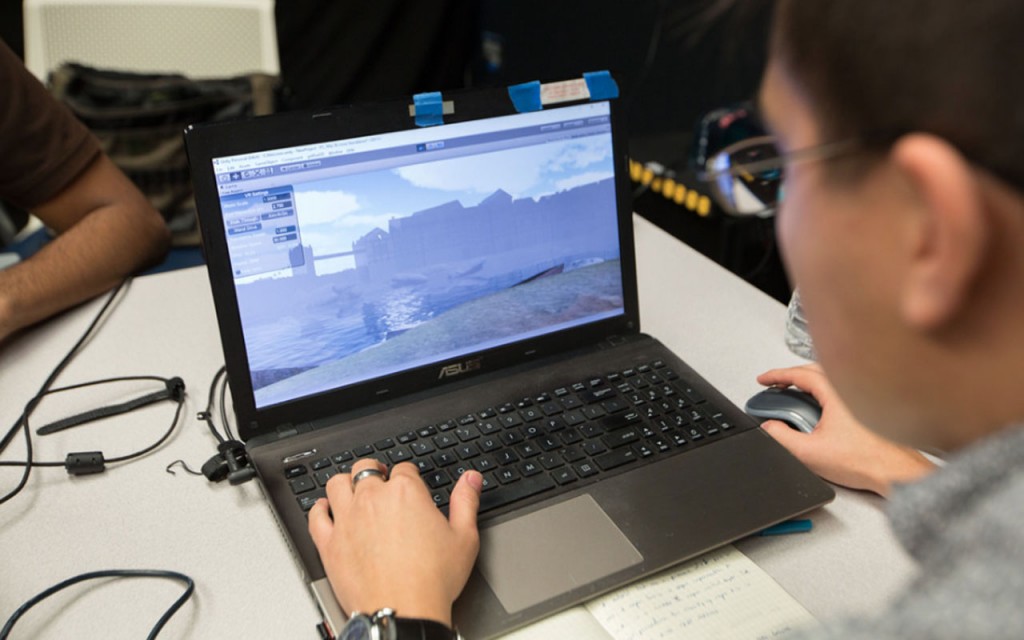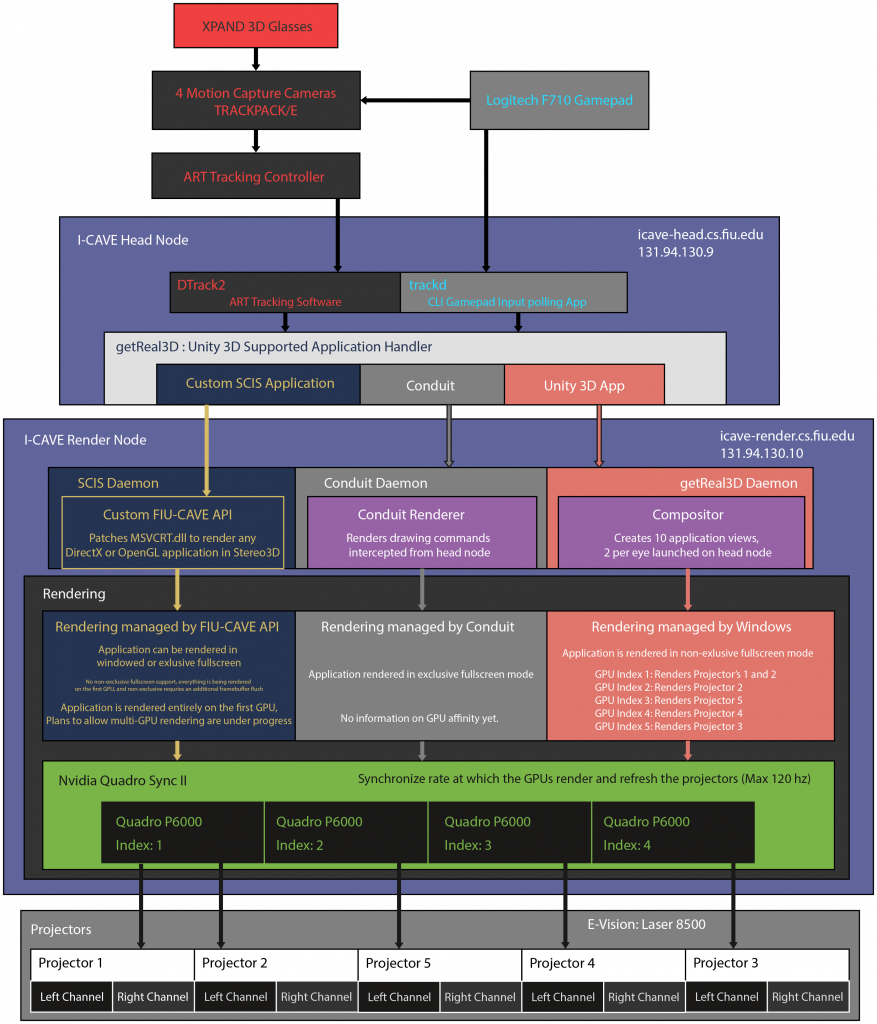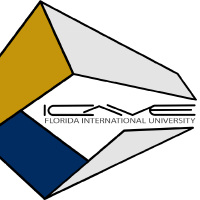SUMMARY: I-CAVE is composed of five 9 x 5 foot high-resolution screens arranged in a hexagonal pattern and a surround sound system that create an immersive virtual reality experience. Hardware and software tracking capabilities are built into the systems to follow movement in the space and coordinate with displayed images for immersion of the users in the simulated environment.

DISPLAY SYSTEM: The FIU ICAVE is a five (5) wall hexagon shaped Mechdyne Segmented Immersive 3D Visualization System (Hex display system). The Hex display system is ~18 ft. 7 7/8 in. wide by ~19 ft. 5 3/4 in. long with each screen ~133 in diagonally. The projection system consists of five (5) digital video projectors mounted in portrait orientation to display the images on the screens. In order to save physical space the lens is an ultra-short throw lens system that only requires ~4 ft. from the screen to display the ~133 in. diagonal image.
Projector specifications:
| Model Name | E-Vision Laser 8500 WUXGA |
| Projector Type | Laser Light Source, Active-Stereoscopic 3D capable, Mounted in Portrait Mode |
| Display Info: | WUXGA 1920×1200 (2.3 million pixels), Up to 120Hz video refresh rate, 16:10 Aspect Ratio |
| Inputs: | DisplayPort 1.1a, HDMI 1.4, 3G-SDI in, 3G-SDI out, VGA / Analog RGB, Component Video, HDBaseT, HDMI In, Digital Link/LAN |
| Lens | Ultra Short-throw: ET-DLE030 0.38:1 lens |
| Stereo Sync Support | BNC 3D sync output for controlling shutter-glasses via IR emitters; BNC 3D sync input for image generator external lock |
| Control Protocol | Ethernet |
| Power Requirements | 100-240VAC 50/60Hz single phase |
| Max Power / Thermal dissipation per projector | 880W / 3000 (3137 @100 VAC) |
COMPUTER GRAPHICS: The FIU ICAVE provides a PC real-time graphics cluster to drive the display system. The cluster consists of two (2) workstations, i.e. One (1) master head application node (w/Nvidia K5200 GPU), and One (1) rendering node with four (4) Nvidia Quadro P6000 GPU cards driving the graphics out to the projectors. The rendering graphics cards are synchronized with each other, the projectors, the IR emitters, optical tracking system and the shutter-glasses for multi-channel 3D stereoscopic operation. The Microsoft Windows 7 Professional 64 bit SP1 operating system is installed on the machines
Specifications of the Master Head Node in the cluster:
| Chassis | 4 RU Tower; Rack Mounting rails |
| CPU | Intel Xeon CPU E5-2687W v3 @ 3.10 GHz |
| Storage | 2TB HDD, 240 GB SSD, 180 GB SSD,(4x) 1TB SSD, 2TB SSD |
| Drives | ODD, BD/DVD/CD read/write, SATA, 14X |
| RAM | 8x 32GB, DDR4 21300 registered, ECC; Total: 256GB RAM |
| GPU | 1 GPU, NVIDIA Quadro P6000 |
| OS | Microsoft Windows 7 Professional x64 SP1 |
Specifications of the Render Node in the cluster:
| Chassis | 4 RU Tower, Rack Mounting rails |
| CPU | Intel Xeon CPU E5-2687W v3 @ 3.10 GHz |
| Storage | 240GB SSD, 2TB SSD |
| Drives | ODD, BD/DVD/CD read/write, SATA, 14X |
| RAM | 8x 32GB, DDR3-1600 registered, ECC, 256 GB |
| GPU | 4x Nvidia Quadro P6000 ; 1x GSU card, NVIDIA Quadro Sync |
| OS | Microsoft Windows 7 Professional x64 SP1 |
Each GPU in the rendering workstation drives two projectors each in clone mode. Clone Mode stereo is an NVIDIA driver setting. When this mode is enable a frame sequential stereo application is rendered such that the left eye image is displayed from one video channel, and the right eye image is displayed from a separate video channel. The Panasonic projectors require separate left and right eye inputs and then generate an active stereo signal output from those two signals. The Clone Mode configuration allows for the VR applications to output the video signal in the format the projectors expect. In this configuration all four video outputs from each GPU will be needed
TRACKING SYSTEM: To enable user-perspective-correct real-time 3D image generation, an integrated optical tracking system is used. The tracking system consist of four (4) ART optical tracking cameras (with mounts), a glasses-mounted optical tracking target, one rack-mounted tracking PC, ART tracking software and Mechdyne trackd software.
The tracking system provides a six-degree-of-freedom optical motion tracking system for the 5 sided HEX. Four (4) infrared tracking cameras are mounted to the Hex structure above the user. A tracking volume within the Hex is provided for a single standing or crouching user with a glasses-mounted head tracker and a hand-held navigation device.
The tracking system uses an active stereo wireless IR shutter-glasses and three (3) wide angle blaster IR emitters mounted to the display system structure to offer optimum coverage for the display system users. G-Sync and 3D stereo-sync cabling are provided between the workstations, projectors and IR emitters. Also, reference sync is sent to the ART optical tracking controller to eliminate any interference between the active stereo system and the tracking system.
The tracking system consists of the following components:
- 4x ARTtrack2 IR tracking cameras, with mounts
- 1x ARTtrack rack-mounted tracking controller with DTrack2 control software
- 2x head-tracking optical targets for attaching to the supplied 3D glasses (one for backup)
- 2x hand-tracking optical targets for attaching to the supplied wireless gamepads (one for
- backup)
- 3x IR emitter blasters to provide IR sync to wireless 3D IR shutter glasses
- Mechdyne trackd for integration of tracking and navigation devices
Mechdyne’s getReal3D brings Unity simulation into VR. getReal3D is a plug-in that makes the Unity game engine compatible with VR equipment for more realistic training and simulation scenarios. getReal3D adds support for 3D stereo, tracking systems, cluster support, and synchronization. getReal3D integrates with Mechdyne’s trackd for hardware communication including support for numerous tracking systems.

SYSTEM DIAGRAM

